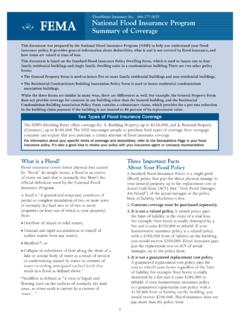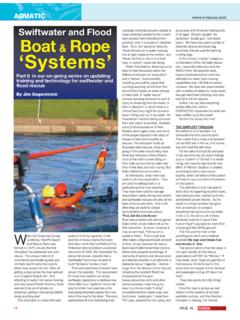Transcription of Excess of Loss Reinsurance - Preferred Re
1 Excess of loss Reinsurance The prior two articles have addressed basic Reinsurance principals and practices and proportional Reinsurance . The antithesis of proportional Reinsurance is non-proportional Reinsurance , often called Excess of loss Reinsurance to avoid having to use big words like antithesis. While some reinsurers complain that their lot in life has always been to deal with an Excess of loss , the phrase is supposed to refer to the practice of providing indemnity over and above, , in Excess of a specific dollar or percentage amount called the ceding company s retention (deductible) or the reinsurer s attachment point. Lest you think that reinsurers are prone to demonstrate a certain degree of affection for their attachments, they can, and do, change them with regularity (and impunity). The ceding company s retention can include indemnity losses as well as loss adjust-ment expenses depending on the party s intentions.
2 Excess of loss (XOL) agreements provide capacity to write risks larger than a ceding company could justify based on its own surplus. XOL also provides severity protection against large losses and / or an ac-cumulation of losses that might prove disconcerting to the ceding company s stakehold-ers. Finally, XOL agreements can be structured to provide protection against frequency losses which are less predictable than might be desired by management and share-holders. XOL agreements are usually priced on the basis of a specified percentage of the ceding company s premium. Since neither the limit provided nor the premium charged is directly proportional to the original loss and premium, these agreements are classified as non-proportional. Third party (casualty) Reinsurance coverages, more often than not, are written on a non-proportional basis.
3 During most of the last century, the majority of first party (property) Reinsurance was written on a proportional basis. However, increasing values and con-centration of risk have led to a concomitant increase in property XOL Reinsurance over the past several decades. Since there are some important differences between property and casualty XOL applications, mostly due to the way each is written on a primary basis (property as a function of specific insured values and casualty on the basis of legal lia-bilities at insured selected limits), each will be discussed separately where appropriate. The principal variations of Excess of loss contracts are Per Risk, Per Occurrence (or Event or Accident), Aggregate and Catastrophe. As their names imply each provides protection on a different basis. Per Risk covers provide indemnification in Excess of a retention or deductible which applies to each and every risk involved in a loss occur-rence.
4 On a Per Occurrence basis, the deductible applies to each loss occurrence (as defined in the contract) without regard to the actual number of risks affected. Aggregate XOL contracts allow a ceding company to recover losses which, when totaled, are larger than a predetermined retention. Finally, Catastrophe XOL, in contrast to coverages which primarily protect individual risks and insureds, is designed to protect the ceding company from an accumulation of losses in a single occurrence which might be large enough to affect the solvency of the company. While these explanations may sound straightforward, reinsurers are seldom limited in their creativity when it applies to concocting variations, combinations and per-mutations of the basics. Particularly when they can name the new variants after them-selves or their companies. When XOL contracts provide protection in a loss layer which is subject to a frequency of loss , they are said to be working covers.
5 It is the normal intent of working covers with reasonably predictable frequency of loss , that the ceding company will pay for its own losses over time, banking profits in good years and borrowing from the bank in lean years. The company is then able to spread its losses over a number of years, achieving some stability of results. If the intent of the ceding company is not to allow reinsurers a reasonable profit over time, coverage may be offered on a pure risk basis, without profit loads, albeit usually at a higher price. As with all agreements, each party should clearly understand the objectives of the other parties to minimize unpleasant surprises down the road. As an aside, casualty reinsurers, not content with a simple definition of working, have inserted an additional distinction called a buffer layer. This arrangement, typical of fac-ultative (individual risk) Reinsurance , refers to capacity provided in Excess of a primary carrier s individual policy limit, but below the retention or deductible required by an ex-cess or umbrella insurer.
6 This layer of indemnity isn t a working layer from the perspec-tive of the primary carrier since the carrier doesn t provide the limits, however, the ex-cess carrier obviously believes otherwise else it would simply reduce its deductible re-quirement. Having dispatched, at least for now, the concept of working and buffer layers, one might anticipate that XOL agreements which respond above a level of predictable frequency would be referred to as non-working covers. Alas, one would be only partially correct - the market prefers the term catastrophe cover Property catastrophe XOL agreements provide protection against an accumulation of losses from such large, unusual and sol-vency threatening events as windstorm, flood, earthquake and terrorism. Casualty cata-strophe programs are alternatively referred to as contingency or clash covers.
7 While the verbiage and application may be different, the intent is the same: protection of the ceding company from a perhaps anticipated, but nonetheless, potentially disastrous loss occurrence. Casualty contingency / clash agreements do not increase the ability of the ceding com-pany to write higher limits of insurance. The name clash originally derives from the possibility of loss from two or more policies being involved (clashing) in the same event, producing a total loss larger than anticipated by the ceding company. A clash agreement is not (supposed to be) exposed to loss from any single primary insurance policy. How-ever, one significant exception to this understanding is XOL agreements written within the policy limits provided, but at an attachment point which is believed to be unlikely to be pierced except in a true catastrophe.
8 Consider, for example, the theoretically unlimited workers compensation exposures re-sulting from an horrific event such as the New York City World Trade Center terrorist at-tack of September the 11th of 2001. Less malignant examples might include the combi-nation of a primary company s general liability, automobile and cargo policies in the same loss occurrence, the addition of a large policy defense expense to a policy limits loss (since defense coverage is provided in addition to the policy limit in most casualty contracts) or even an automobile accident involving two (or more) of a company s in-sureds. To summarize: non-proportional treaties differ from proportional agreements in several important respects. Not the least of which is that ceding companies and reinsurers divvy up premium and loss according to a previously agreed percentage in proportional agreements, while in XOL treaties, the ceding company pays 100% of the loss up to its agreed upon retention, but pays the reinsurer a premium which is not directly propor-tional to its retained limit.
9 The principal forms of XOL Reinsurance are Per Risk, Per Occurrence (Event, Accident), Aggregate and Catastrophe. Excess of loss programs are usually structured in layers, one atop another until the ceding company is satisfied that its stakeholders can sleep soundly at night or until it runs out of money to buy additional layers, whichever occurs first. Agreements can be working (Per Risk, Per Occurrence, Aggregate) where partic-ipants are agreed that frequency of loss can reasonably be ascertained. They are non-working (catastrophe, clash, contingency) where predictability is suspect while the con-sequences of lack of protection are severe. Perhaps the most important message to take away from these articles is that no type of Reinsurance exists in a vacuum. Each and every Reinsurance program should be de-signed with the specific requirements of the individual ceding company in mind, assum-ing those requirements are neither illegal or illogically absurd.
10 Proportional Reinsurance and non-proportional Reinsurance should work in tandem to provide the protection sought at a price which is credible (as determined by managements and dueling actuar-ies) and which provides an acceptable margin of profit for the reinsurer. The author, James A. Warters, is Vice President and Northeast Regional Manager for Preferred Reinsurance Intermediaries of Columbia, South Carolina. When visiting the home office, he can be reached through the receptionist at 803-790-4800. His office is in Rockaway, New Jersey, 973-586-3105.







